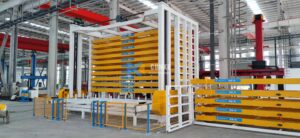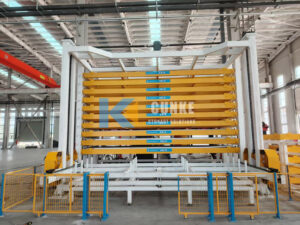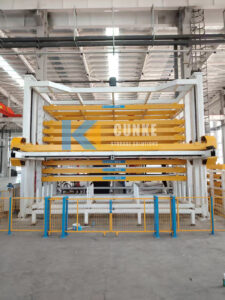Introduction: When Sheet Metal Becomes a Bottleneck
In many workshops and fabrication plants, sheet metal is the backbone of production. It feeds laser cutting machines, bending equipment, and assembly lines. Yet, for all its importance, sheet metal storage is often overlooked.
Stacks of 3×1.5m or 6x2m steel sheets pile up on the floor, workers scramble to find the right piece, forklifts navigate dangerously tight aisles, and heavy bundles are shifted manually. The result? Wasted time, wasted space, and increased safety risks.
This is where the automated sheet metal storage system (commonly called a Automated Sheet Tower) comes into play. Designed for modern sheet metal workshops, it eliminates manual chaos and replaces it with speed, precision, and safety.

Why Traditional Storage Fails Today
Before we explore what the automated system offers, let’s understand why traditional storage methods are no longer enough:
- Floor stacking is inefficient. Workers spend minutes—or even hours—just moving bundles around to reach the right sheet.
- Wasted vertical space. Most workshops have 8–12m ceilings, yet only the bottom 2m are used for storage. That’s like renting a three-story house and living only on the ground floor.
- Safety risks. Heavy steel sheets and bundles are prone to tipping, slipping, or injuring workers during manual handling.
- Material damage. Aluminum sheets bend easily, coatings get scratched, and poor stacking leads to waste.
- Labor dependency. As orders increase, adding more workers is not a scalable or sustainable solution.
Simply put: traditional racking and floor storage are bottlenecks in a modern, high-volume sheet metal factory.
What Is an Automated Sheet Metal Storage System?
At its core, the system is a vertical racking tower designed specifically for sheet metal pallets. Instead of piling sheets on the floor, each bundle is stored neatly in individual drawers or levels.
The system integrates automation in two ways:
- Automated retrieval and storage – With the push of a button, the rack brings the required pallet to ground level in seconds.
- Integration with laser cutting machines – When paired with an RGV (rail-guided vehicle) and robotic arm, the system can automatically feed sheet metal directly into the cutting machine.
Think of it as giving your warehouse both a brain (software and automation) and muscle (servo-driven motors and gantry systems).

Key Features End Users Care About
- High Efficiency: 15 Pallets per Hour
One of the strongest selling points is efficiency. A single-tower rack can handle up to 15 pallets per hour, far beyond what a team of workers can achieve manually.
- No more searching – The system tracks where every pallet is stored.
- Faster changeovers – Material access time is cut to seconds.
- Reduced downtime – Production lines no longer wait for manual feeding.
For high-frequency workshops, this translates to guaranteed throughput and shorter delivery times.
- Flexible Layout Options
Every factory layout is different, so the system offers multiple configurations:
- Single-Tower Rack – The basic unit, ideal for smaller workshops.
- Double-Tower (Face-to-Face) Layout – Two towers installed opposite each other, sharing a central aisle. This design maximizes storage while saving floor space.
- Multi-Row Linked System – Several towers aligned side by side, sharing one lifting mechanism. This significantly reduces cost and simplifies management
This flexibility means customers can scale the system to their factory size and production needs.
- Automation Ready: RGV + Robotic Arm Feeding
The real leap forward comes when the rack integrates with production:
- RGV (Rail-Guided Vehicle) runs on a floor track to move sheet pallets from the rack to the cutting area.
- Robotic Arm lifts the sheet from the pallet and places it precisely on the laser cutting machine’s table.
This creates a seamless, fully automated material feeding process. No forklifts, no manual lifting, no wasted time
- Heavy-Duty Capacity: 10 Tons per Level
End users often worry: “Can it handle heavy steel plates?” The answer is yes.
- Each level can support up to 10 tons, designed with finite element analysis, load tests, and safety factors built in.
- Common design allows for 20 levels when each level carries ~3 tons, depending on warehouse height.
- Whether it’s mild steel, stainless steel, or heavy plates, the system can safely store and retrieve without risk of collapse
- Sheet Size Compatibility: Up to 6000 × 2000 mm
The system supports a wide range of sheet sizes:
- Maximum size: 6000 × 2000 mm (4m × 2m).
- Most common: 3015 mm (3m × 1.5m), widely used in laser cutting workshops.
- Custom options available for non-standard sheet formats.
This ensures compatibility with both current and future production demands.
- Smart Electrical System and Ease of Installation
A frequent concern from workshop managers: “Will installation be complicated?”
- Pre-wired control box – Shipped with all wiring complete, so customers don’t need to handle electrical connections.
- Servo motors – Provide high precision, fast response, and reliability, ideal for frequent start/stop cycles.
- Professional commissioning – While basic installation can be done by non-electricians, final tuning must be done by professionals to ensure smooth performance
This design philosophy means the system is plug-and-play for end users, with minimal downtime during installation.
Who Benefits the Most?
The automated sheet metal storage system is not just for mega-factories. It creates value in:
- Laser cutting workshops – Seamless feeding boosts machine utilization rates.
- Sheet metal fabrication plants – Cleaner floors, faster access, and fewer damaged sheets.
- Automotive and aerospace parts suppliers – Traceable storage ensures consistency and quality.
- Shipbuilding and heavy industry – Safe handling of oversized and heavy plates.
- Job shops with growing orders – Scale storage capacity without moving to a bigger facility.
Return on Investment: Why It Pays for Itself
End users don’t just want technology—they want results. Here’s how ROI is realized:
- Labor savings – Reduce the number of workers needed for material handling.
- Higher throughput – 15 pallets/hour translates to faster delivery and more orders completed on time.
- Better space utilization – Free up to 50% of floor space, delaying or avoiding costly factory expansions.
- Reduced scrap and damage – Materials are stored safely, with fewer bent sheets or scratched coatings.
- Worker safety and morale – Less heavy lifting, fewer injuries, and happier employees.
Most customers find the system pays for itself within 1–3 years, depending on usage intensity.

Conclusion: Don’t Expand Space, Upgrade Your System
When your workshop feels too crowded, the answer isn’t always a bigger building. Often, the real problem is outdated storage methods.
An automated sheet metal storage system transforms disorganized piles into a smart, efficient, and safe workflow. With high load capacity, automation-ready design, and proven ROI, it’s a long-term solution for manufacturers who want to stay competitive.
Ready to see how much space and time you could save?
Contact our team today for a free consultation and get a tailored storage plan for your workshop.
